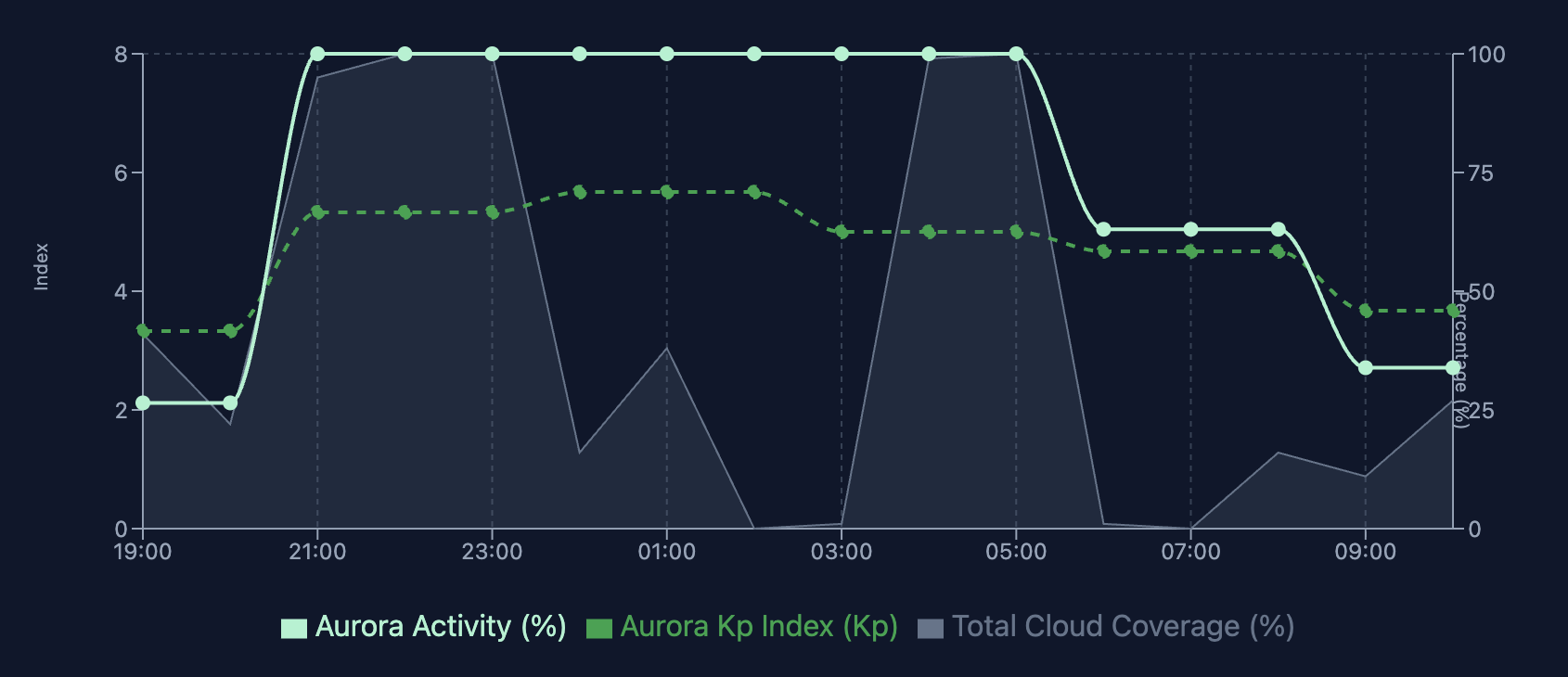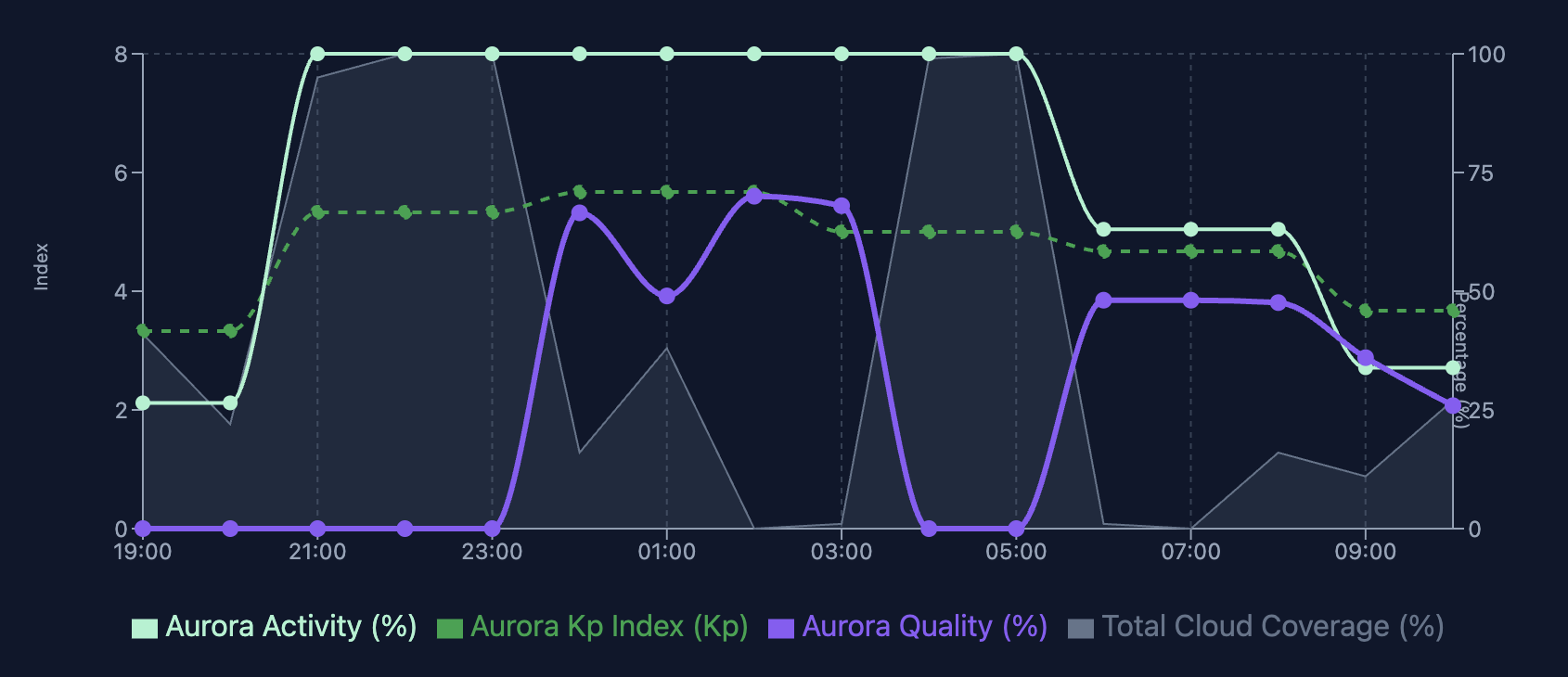How to Photograph the Northern Lights (Without the Guesswork)
Learn when and where to catch the aurora borealis with confidence. Understand Kp forecasts, what actually matters for photography, and how to stop missing opportunities.

How to Photograph the Northern Lights (Without the Guesswork)
You check the aurora forecast. It says there’s activity tonight. You drive two hours to your favorite dark sky spot, set up your camera in the freezing cold, and… nothing. Just clouds. Or the aurora is barely visible on the horizon. Or it’s still too light outside.
Sound familiar?
The problem isn’t bad luck, it’s that aurora forecasting is genuinely complicated. You need the right magnetic storm activity for your latitude, clear skies, darkness, and ideally a night without a full moon washing everything out. Miss any one of these factors and you’ve wasted an evening.
This guide will show you how to read aurora forecasts properly, understand what actually matters for photography, and set up alerts so you only head out when conditions are actually good.
You’ll need a free PhotoWeather account to follow along with the examples.
First: What Actually Creates the Northern Lights?
Here’s the simple version: The sun constantly throws charged particles into space (called solar wind). When these particles hit Earth’s magnetic field, they get funneled toward the poles. As they collide with our atmosphere, they create those dancing curtains of light.
The stronger the solar activity, the farther from the poles the aurora becomes visible. During major storms, people in southern Canada or northern US states can see them. During quiet periods, you need to be in places like northern Norway or Alaska.
This strength is measured by something called the Kp index, which runs from 0 to 9.
Understanding Kp Index
The Kp index measures geomagnetic storm intensity. Think of it like this:
- Kp 0-2: Quiet. Only visible way up north (above 65°N—think northern Scandinavia, Alaska, northern Canada)
- Kp 3-4: Minor storm. Visible at mid-high latitudes (55-65°N—southern Scandinavia, Scotland, southern Alaska)
- Kp 5-6: Moderate storm. Can reach lower latitudes (50-55°N—northern US/Canada border, northern UK)
- Kp 7-9: Major storm. Visible much farther south (sometimes as far as 45°N or below)
Here’s the catch: A Kp 5 forecast means nothing if you don’t know your latitude. If you’re in Tromsø (69°N), a Kp 3 is exciting. If you’re in Seattle (48°N), you need at least Kp 6 or 7.
This is why raw Kp numbers can be misleading.
The Three Numbers That Actually Matter

1. Aurora Activity (Your Latitude-Adjusted Score)
This is a 0-100 score that accounts for where you actually are. A Kp 3 storm gets scored differently in Alaska versus Montana.
- 0-30: Weak, unlikely to be visible
- 30-60: Moderate, in the upper range it may be just visible
- 60-100: Strong, good to excellent possibilities (if earth weather aligns)
This number is way more useful than raw Kp because it’s personalized to your location.
2. Will It Be on the Horizon or Overhead?
The system classifies the expected aurora visibility:
- None: Storm isn’t strong enough to reach your latitude
- Horizon: Aurora visible low on the northern horizon
- Overhead: Aurora directly above you (these are the spectacular ones)
This matters for composition. If it’s a horizon aurora, you’ll want interesting foreground elements. If it’s overhead, you can shoot straight up for full-sky coverage.
3. Photography Score (The One Number to Rule Them All)
This is where it gets good. The Aurora Quality score (0-100%) combines everything:
- Storm strength for your latitude
- If the aurora would be at the horizon or directly overhead
- Whether it’s dark enough (aurora don’t show up during twilight)
- Cloud coverage (nothing ruins an aurora shoot like clouds)
- Visibility (bonus points for clear air)
The score drops to zero if:
- It’s not dark enough (sun hasn’t set far enough below the horizon)
- Clouds are over 50%
- The storm isn’t strong enough for your latitude
How to read it:
- 0-30%: Don’t bother
- 30-60%: Possible if you’re experienced and willing to gamble
- 60-80%: Good odds—worth planning a trip
- 80-100%: Drop everything and go
Pro users can see this score overlaid on their weather charts (historical & forecasted), but you can create a rule to get alerted when aurora quality is high without any subscription.

Why Cloud Forecasts Are Tricky for Aurora
Unlike golden hour (where you only care about clouds on the horizon), aurora can appear across the entire sky. A single-point cloud forecast might say “30% clouds” but those clouds could all be in the north, blocking your view.
This is where PhotoWeather’s Plus and Pro tiers help:
Free tier: Uses the cloud forecast directly at your location.
Plus/Pro tiers: Samples cloud coverage in all directions around your location and averages it. This gives you a much better picture of whether the whole sky will be clear.
Real example: Your location shows 40% clouds, which seems borderline. But the multi-point analysis reveals those clouds are all to the south—the northern sky is clear, and the aurora will be visible.
How to Actually Read the Forecast
Once you’re signed in:
- Open your location’s weather chart
- Toggle on Aurora Activity, Kp Index, and Cloud Cover
- Look for these conditions lining up between evening and pre-dawn:
- Kp index ≥ 3 (adjust based on how far north you are)
- Aurora activity ≥ 40
- Horizon or overhead category
- It’s fully dark (well after sunset)
- Cloud cover ≤ 30% (ideally under 10%)
Pro users can skip all this and just look directly at Aurora Quality scores.
Setting Up Alerts (So You Stop Missing Opportunities)
Instead of checking forecasts obsessively, let the system watch for you.

The Aurora Borealis Hunt Template
This is a ready-made alert rule that monitors all the factors.
To set it up:
- Go to Rules → Add Rule → Templates → Aurora Borealis Hunt
- Review the trigger conditions (Aurora quality ≥ 50%, moon not too bright)
- Enable it for your locations
The rule triggers when there’s a genuine photography opportunity—not just aurora activity, but actual shootable conditions.
To customize:
- Duplicate the template rule
- Edit the Aurora Quality threshold
- Use “Test against recent data” to see what opportunities it would have caught
When the rule triggers, you’ll get a notification showing the opportunity window, quality score, and key metrics—so you can decide if it’s worth heading out.
When to Actually Shoot
Best Months (Northern Hemisphere)
- September-October: Peak activity around the equinox, and it’s still warm enough to stand outside for hours
- February-March: Second equinox peak, cold but doable
- November-January: Darkest skies, but brutally cold
Best Time of Night
The aurora is most active between 10 PM and 2 AM local time. But it can happen anytime it’s dark, so stay flexible.
Where to Go Based on Your Latitude
- 65-70°N (northern Norway, Iceland, northern Alaska): You’ll see aurora regularly, even at low Kp
- 55-65°N (southern Scandinavia, southern Alaska, northern Scotland): Good displays at moderate Kp (4-5)
- 45-55°N (northern US states, southern Canada): You need strong storms (Kp 6+), but they can be incredible
- Below 45°N: Only during major geomagnetic storms (Kp 7-9)
What to look for in a shooting location:
- Dark skies away from city lights
- Clear view to the north
- Interesting foreground (lake, mountains, trees)
- Accessible in winter/snow
Camera Settings to Start With
- ISO: 1600-3200 (adjust based on brightness)
- Aperture: As wide as your lens goes (f/1.4 to f/2.8 ideally)
- Shutter speed: 5-15 seconds (faster if the aurora is moving quickly)
- Focus: Manual focus on stars or distant light
- White balance: 3500-4000K (you’ll adjust this in post)
Field tips:
- Scout your location in daylight so you know your composition before dark
- Arrive early and get focused before the show starts
- Shoot RAW for maximum editing flexibility
- Set up an intervalometer for timelapse
- Dress warmer than you think you need to
What to Do When Conditions Aren’t Perfect
- 30-40% clouds: Sometimes you can shoot through thin clouds for interesting effects
- Full moon: It washes out faint aurora but lights up your foreground nicely
- Lower latitude: Only really major storms will be visible but the aurora score adjusts for this automatically
- Uncertain forecast: The closer in time to the forecast you are the more reliable it will be
Common Questions
What Kp do I need where I live?
It depends on how far north you are:
- Above 60°N: Kp 2-3 is often enough
- 55-60°N: Kp 3-4 for good shows
- 50-55°N: Kp 5-6
- 45-50°N: Kp 6-7 or higher
- Below 45°N: Kp 8-9 (these are rare major storms)
The Aurora Activity score handles this automatically for your location.
Do I need to pay for Pro to forecast aurora?
Nope. The free tier includes full aurora forecasting:
- Aurora activity scores
- Kp index predictions
- Aurora Quality score
- Alert templates
The paid tiers give you:
- More frequent updates (every 3 hours or hourly vs. daily)
- Longer forecasts (7-14 days vs. 3 days)
- Multi-point cloud analysis for better accuracy
- (Pro only) Visual Aurora Quality charts showing trends
But everyone gets the same core conditions and alerts.
What’s the difference between Activity and Quality?
- Activity: How strong is the geomagnetic storm for your latitude?
- Quality: Can you actually photograph it right now? (factors in darkness, clouds, visibility)
Use Quality for alerts. Use Activity when you want to understand the storm strength.
Why is Quality showing zero when Activity is high?
Because it’s missing something critical:
- Not dark enough yet (sun still above horizon)
- Too cloudy (over 50% coverage)
- Storm isn’t strong enough for your latitude
High Activity doesn’t mean much if you can’t see the aurora through clouds or it’s still twilight.
Getting Started
- Create a free account
- Add your locations (or where you plan to chase aurora)
- Open the weather chart and toggle on Aurora Activity, Kp Index, and Cloud Cover
- Add the Aurora Borealis Hunt template to your locations
- Adjust the quality threshold if needed (based on your latitude)
- Test it against recent data to see what it would have caught
That’s it. The next time there’s a legitimate aurora photography opportunity, you’ll know about it.
